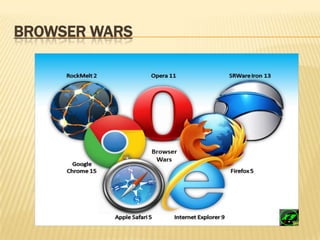Browser wars
- 1. BROWSER WARS
- 2. WHAT IS BROWSER WARS ? Browser Wars is a metaphorical term that refers to competitions for dominance in usage share in the web browser marketplace. The term is often used to denote two specific rivalries: the competition that saw Microsoft's Internet Explorer replace Netscape's Navigator as the dominant browser during the late 1990s and the erosion of Internet Explorer's market share since 2003 by a collection of emerging browsers including Mozilla Firefox, Google Chrome, Safari, and Opera.
- 3. MOSIAC In1993 Cello, Arena, Lynx, tkWWW and Mosaic were released. The most influential of these was Mosaic, developed at National Center for Supercomputing Applications(NCSA). Marc Andreessen, founded Mosaic Communications Corporation, the company was renamed Netscape Communications Corporation and the browser Netscape Navigator. By 1995, helped by the fact that it was free for non- commercial use, the browser dominated the emerging World Wide Web.
- 4. FIRST BROWSER WAR In 1995 Microsoft licensed Mosaic to create Internet Explorer 1.0,which it had released as part of the Microsoft Windows 95 Plus! Pack in August. During this period Development was rapid and new features were routinely added, including Netscape’s JavaScript and proprietary HTML tags such as <blink> and <marquee>. Internet Explorer began to approach feature parity with Netscape with version 3.0, offering scripting support and market’s first CSS implementation.
- 5. Till 1997 market share of Netscape was 72% as compared to IE’s 18%. Internet Explorer 4 changed the tides of the browser wars. It was integrated into Microsoft Windows. Users were discouraged from using competing products because IE was "already there" on their PCs. The first browser war ended with Internet Explorer having no remaining serious competition for its market share. Its market share was 96% in 2002. This also brought an end to the rapid innovation in web browsers, until 2006 there was only one new version of Internet Explorer since version 6.0 had been released in 2001
- 6. REASON FOR NETSCAPE'S FAILURE Netscape began with about 80% market share and a good deal of public goodwill, but as a relatively small company, with its income from single product Netscape's total revenue never exceeded the interest income generated by Microsoft's cash on hand. Microsoft's vast resources allowed them to make IE available without charge. Microsoft Windows had over 90% share of the desktop operating system market. IE was bundled with every copy of Windows; therefore Microsoft was able to dominate the market share easily as customers had IE as a default. In 1998 Netscape, the company, was acquired by America Online for US$4.2 billion.
- 7. SECOND BROWSER WAR On November 9, 2004 non-profit Mozilla Foundation released Mozilla Firefox 1.0 which included features, like tabbed browsing and a separate search bar. In 2005, Opera browser became freeware, and in June 20, 2006, Opera Software released Opera 9 including an integrated source viewer. It was the first Windows browser to pass the Acid2test. On October 24, 2006, Mozilla released Mozilla Firefox 2.0. It included the ability to reopen recently closed tabs, a session restore feature to resume work where it had been left after a crash.
- 8. Internet Explorer 8 was released on March 19, 2009. Google released the Chrome browser for Microsoft Windows on December 11, 2008, using a faster JavaScript engine called V8. An open sourced version for the Windows, Mac OS X and Linux platforms was released under the name Chromium. According to Net Applications, Chrome had gained a 3.6% usage share by October 2009. During Dec 2009 and Jan2010, Firefox 3.5 was the most popular browser replacing IE7. In October 2010, Internet Explorer had for the first time dropped below 50% market share to 49.87% in their figures.
- 9. During this era, all major web browsers implemented support for HTML5 video. The release preview of Internet Explorer 11 was released on September 17, 2013. On April 10 2014 Crome version 35 was released. As of Jan 2014 Crome had 46.6% of the browser market share, with closest rival being IE at 24.6%.










